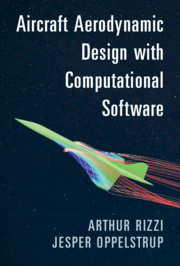Book contents
- Frontmatter
- Contents
- List of Figures
- List of Tables
- Preface
- Acknowledgements
- Abbreviations
- Nomenclature
- 1 Introduction to Aircraft Aerodynamic Design
- 2 Airflow Physics and Mathematical Models
- 3 Concepts and Computational Models in Wing Design
- 4 Finite-Volume Schemes for the Euler Equations
- 5 Airframe Computer-Aided Design and Automated Grid Generation
- 6 Computational Fluid Dynamics for Steady and Unsteady Flows
- 7 Fast Computation of Airfoil Flow
- 8 Airfoil Design Considerations
- 9 Wing Design Considerations
- 10 Configuration Development and Flying Qualities
- 11 Airload–Structure Interactions and Aero–Elastic Effects
- Index
9 - Wing Design Considerations
Published online by Cambridge University Press: 30 April 2021
- Frontmatter
- Contents
- List of Figures
- List of Tables
- Preface
- Acknowledgements
- Abbreviations
- Nomenclature
- 1 Introduction to Aircraft Aerodynamic Design
- 2 Airflow Physics and Mathematical Models
- 3 Concepts and Computational Models in Wing Design
- 4 Finite-Volume Schemes for the Euler Equations
- 5 Airframe Computer-Aided Design and Automated Grid Generation
- 6 Computational Fluid Dynamics for Steady and Unsteady Flows
- 7 Fast Computation of Airfoil Flow
- 8 Airfoil Design Considerations
- 9 Wing Design Considerations
- 10 Configuration Development and Flying Qualities
- 11 Airload–Structure Interactions and Aero–Elastic Effects
- Index
Summary
Wings for three speed regimes with potential for efficient flight are investigated. We compute and analyse our own data for the designs in search of a coherent explanation for why these aircraft are the shapes they are for the tasks they have to perform. The subcritical speed case is a straight, high-aspect-ratio wing designed to maintain attached flow to the trailing edge. Two swept wings for supercritical flow are studied: the first one is from the late 1940s, when transonic problems were not understood. The second is a modern transport wing (Common Research Model (CRM)) showing what was learned in 70 years of transonic wing design. Attached flow is harder to sustain since shock waves interacting with the boundary layer may cause premature separation and drag increase. The slender Mach 2 Concorde-like example is marked by its low-aspect-ratio delta-like wing. This class breaks the paradigm of attached flow. Instead, the design creates a lift-enhancing controlled vortex separating from the leading edge, as seen also on modern fighters. Most of the work analyzes a given shape for aerodynamic performance. In our discussion of the CRM wing, we examine the minimum wave drag shape produced by mathematical optimization to learn how the optimizer changed the geometry.
Keywords
- Type
- Chapter
- Information
- Aircraft Aerodynamic Design with Computational Software , pp. 300 - 351Publisher: Cambridge University PressPrint publication year: 2021

